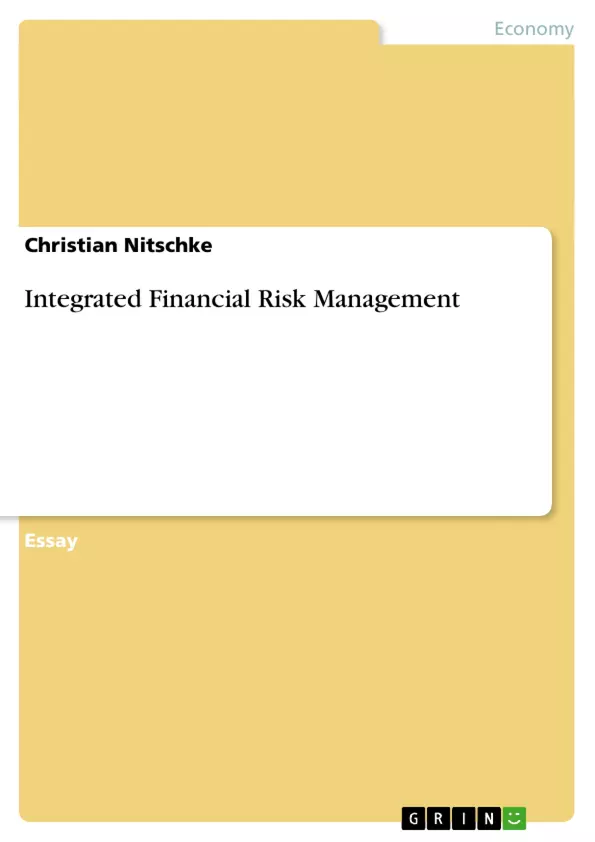The objective of an Integrated Risk Management System is to maximise shareholder value. Shareholder Value is mainly determined by t he Market Value (MV) which is the most aggregated measure for the value of a company. MV is influenced by future cash flows which are exposed by the risk of Exchange Rate changes. This risk can be hedged by using financial instruments such as derivatives or it can be minimized by applying operational hedging which involves strategic considerations like plant locations and sources of input.
The business of the company assumed in this case consists of Export & Import trades to a variety of countries as well as of Equity Investments in Africa and Asia. An assessment of the countries and areas shows actual economical and political developments to evaluate the most efficient Risk Management decisions.
By looking at the Direct Economical Exposure the extent by which the company is threatened by Exchange Rate changes is examined. Furthermore the Value at Risk approach and the Scenario method is explained and applied to draw a picture of the size and likelihood by what extent the enterprise is exposed to Financial Risks.
It is suggested to use the Dynamic Hedging technique to overcome fluctuating cash flows. Another proposal is to apply Multi-Currency Accounting which supports the company to comply with regulatory standards and provide management information to efficiently control foreign business.
Inhaltsverzeichnis (Table of Contents)
- DECLARATION OF ORIGINAL WORK
- TERMS OF REFERENCE
- EXECUTIVE SUMMARY
- TABLE OF CONTENTS
- 1 COMPANY RISK ASSESSMENT
- 1.1 RISK MANAGEMENT OBJECTIVES
- 1.2 IMPORT & EXPORT BUSINESS
- 1.3 EQUITY INVESTMENTS
- 1.4 CHANNELS OF RISK
- 1.5 REGULATIONS
- 1.6 PLAN OF DEVELOPMENT FOR A RISK MANAGEMENT STRATEGY
- 2 MANAGING STRATEGIC EXCHANGE RATE EXPOSURE
- 2.1 VALUE AT RISK (VAR)
- 2.2 SCENARIO ANALYSIS
- 3 RISK MANAGEMENT STRATEGY
- 3.1 DYNAMIC HEDGING
- 3.2 MULTI-CURRENCY ACCOUNTING
- 4 REFERENCES
- APPENDIX A
- APPENDIX B
Zielsetzung und Themenschwerpunkte (Objectives and Key Themes)
This paper aims to develop an Integrated Financial Risk Management System for a multinational company with diverse international operations. The system focuses on managing foreign exchange rate risks by analyzing the economic and political situations of relevant countries, assessing potential exchange rate movements, and identifying channels of risk exposure. The paper further explores regulatory considerations and proposes methods for mitigating these risks.
- Maximising shareholder value by managing the impact of exchange rate changes on market value.
- Analyzing the economic and political environments of countries involved in the company's operations to assess potential exchange rate risks.
- Examining the various channels through which exchange rate changes can affect the company's business activities.
- Exploring the regulatory environment and its influence on risk management strategies.
- Developing a comprehensive risk management strategy using financial and operational hedging methods.
Zusammenfassung der Kapitel (Chapter Summaries)
- Chapter 1: Company Risk Assessment
- Introduces the concept of maximizing shareholder value as a primary objective of financial and corporate management.
- Explores the impact of exchange rate changes on market value and the importance of risk management in mitigating this exposure.
- Discusses operational and financial hedging strategies, highlighting the focus of this paper on financial hedging methods.
- Introduces the concepts of translation exposure and transaction exposure, outlining their differences and relevance to the company's risk profile.
- Chapter 2: Managing Strategic Exchange Rate Exposure
- Explains the Value at Risk (VAR) approach as a method for quantifying the potential losses from exchange rate fluctuations.
- Introduces Scenario Analysis as a tool for assessing the likelihood and impact of different exchange rate scenarios.
- Chapter 3: Risk Management Strategy
- Discusses the use of Dynamic Hedging as a technique for mitigating fluctuating cash flows through the use of financial instruments.
- Explores the benefits of Multi-Currency Accounting in ensuring compliance with regulatory standards and providing valuable management information for international business operations.
Schlüsselwörter (Keywords)
This paper focuses on the critical aspects of financial risk management, particularly in an international context. Key terms include: hedging, financial risk, risk management, Value at Risk (VAR), scenario analysis, dynamic hedging, and multi-currency accounting.
- Quote paper
- Christian Nitschke (Author), 2003, Integrated Financial Risk Management, Munich, GRIN Verlag, https://www.grin.com/document/25027



